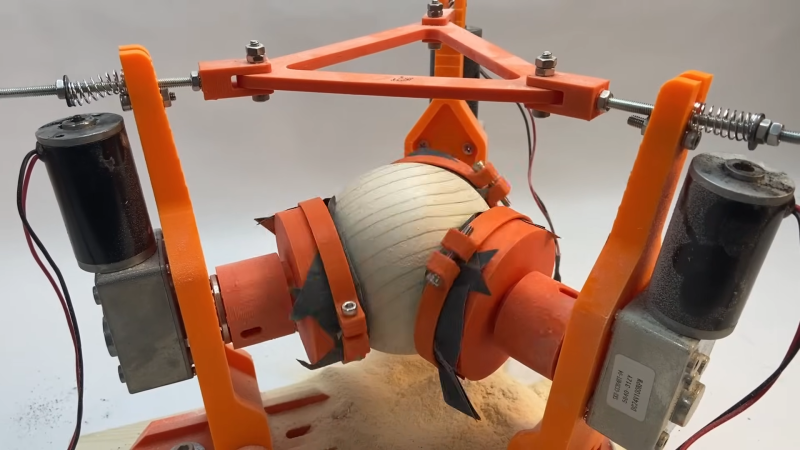Alright, everyone has 30 seconds to get all the jokes out of their system before we proceed with a look at this 3D printed wooden ball polisher.
Ready?
Theoretically, making a sphere out of any material should be easy. All you need to do is pick a point in space inside the material and eliminate everything more than a specified distance from that point. But in practice, sphere-making isn’t quite so simple. The machine [Fraens] presents in the video below is geared more toward the final polish than the initial forming, with a trio of gear motors set 120 degrees apart driving cup-shaped grinding pads.
Constant pressure on the developing sphere is maintained with a clever triangular frame with springs that pre-load the arms and pull them in toward the workpiece, but stop at the desired radius. The three grinding pads are fitted with sandpaper and constantly turn, wearing down the rough piece until it reaches the final diameter. The machine also supports more aggressive tooling, in the form of hole saws that really get to work on the rough blank. Check it out in the video below.
While we appreciate the fact that this is 3D printed, watching the vibrations it has to endure while the blank is still rough, not to mention all the dust and chips it creates, makes us think this machine might not stand up for long. So maybe letting this circular saw jig cut out a rough ball and using this machine for the final polish would be a good idea.

















That’ll be 30 secs then
It reminds me of a bowling ball polisher.
Homer, have you been using the Shine-O-Ball-O?
All that’s left is a machine that lasers name of the suspect who is about to commit crime, and dye the ball in red for that rare crime.
Pink polka dots!
It looks sturdy enough to me. If you’ve made something yourself, you can treat printed parts as sort of (long-lasting) consumables, and that might even be a selling point as you get to refine individual parts over time.
For that reason though, I’m always a bit skeptical of heat-set hardware, as then you’re combining the shorter life of printed parts with the need-to-buy-replacementsness of ready-made parts, which is the worst of both worlds. So I’m not sure about the little joints holding the triangle here.
But where parts can be replaced by literally pushing a button, it doesn’t matter so much if they won’t last for generations.
Impute: To imply/compute a value based on someone’s actions. e.g. You think your time is worthless.
So does everybody who posts on this dumpster fire of a website…
Have you ever heard of “irony”?
Are you trying to explain a joke you didn’t get?
You are posting on a website you describe as a dumpster fire. If it’s so bad why read it? Why contribute?
exactly. wooden screws are totally fine for most applications where you don’t need to screw and unscrew a part regularly and if you do most of the time an embedded or slit in hex-nut does the job wonderfully. brass heat set nuts look nice and refined but when does that actually matter?
Ball Fondlers! (ref: Rick and Morty)
So.. yo put a ball inside and you get … a slightly smaller ball. Awesome!
So, is there something about this method of grinding that makes a spheroidal object more sphere-like?
Does this actually improve the spherical figure, or does it just polish the existing shape?
Yes, it is self centring. It is based on the traditional lapidary technique for cutting and polishing a stone sphere. The compliance from the pivots at the base and the springs at the top allow the arms to flex and concentrates more pressure onto the high-spots of the rough ball, perfecting the spherical shape.
This is great. Well done Fraens, This is a lot of work, very well resolved and the documentation looks great too. I have had hacking together a Sphere polishing machine on my long list of “projects to make one day” for 25 years. I need one for polishing Acrylic contact juggling balls. I’m inspired to move it up my list a bit further.
reproduce this in stone
Hobby lobby has granite and jade spheres.
https://gprivate.com/69jv5 here you go